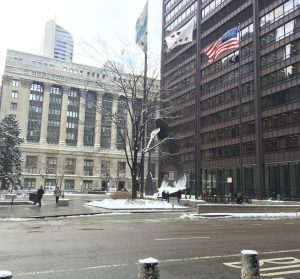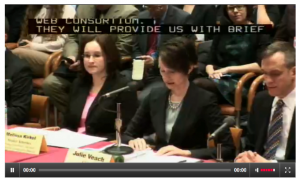A news report from Ed Finkel, New Communities Program
Residents of South Chicago and surrounding neighborhoods visited eco-friendly buildings and other environmentally significant sites in their communities during the Green Summit Tour on May 29.
Coordinated by NCP lead agency Claretian Associates and narrated by Ald. John Pope (10th), the three-hour-long meandering journey on a bus decked out like an old-school streetcar — with park-bench-style seating and a wooden interior — capped a month’s worth of green events and celebrations in South Chicago.

The bus left from Villa Guadalupe senior center on 91st Street. Pope tipped his cap to several projects Claretian has championed, like energy-efficient homes built through the New Homes for Chicago program, with features like Energy Star appliances; the community garden outside the South Chicago Arts Center, where local residents regularly tend their plantings; and People’s Park, a peaceful haven on what had been three trash-strewn city lots notorious for fly dumping and drug dealing.
“We can see the impact of Claretian’s works in South Chicago,” Pope said. “Across the country, faith-based organizations like Claretian are stepping forward as stewards of the Earth.”
The benefits range from the fact that “people with limited incomes can live the American Dream” through subsidized housing, to the insights youth gain about growing vegetables. “People, especially kids, often times don’t realize where food comes from,” he said.
At the eastern end of 87th Street, the bus reached the gate of the 567-acre site that once housed the USX steel plant. Now closed to the public, the site — environmentally remediated to residential standards — will have plenty of public access once it’s developed as a mixed-use community, Pope said.
The tour passed LEED-certified infill housing (designated as eco-friendly by the U.S. Green Building Council), rooftop gardens at Comer Youth Center and Trinity Hospital, and solar trash compactors along Commercial Avenue that condense materials and bring both financial savings and preservation of landfill space.
The bus made two stops at buildings that Pope recognized for their eco-friendliness by presenting plaques to their denizens. The Rainbow clothing store at 91st and Commercial is the community’s first LEED-certified building, designed to sit right at the sidewalk for maximum pedestrian-friendliness. And the Victory Centre senior housing complex on 92nd Street has eco-friendly features like a rooftop garden.
“That’s good from an environmental perspective, but it’s also good from a social perspective,” Pope said, noting that the complex has helped to keep seniors from South Chicago near home. “They don’t want to pick up and move to Calumet City because that’s the nearest housing for seniors. The open space is more than would be required, which leads to a nice atmosphere.”
The year-old complex for those 65-and-older has 87 of its 112 units occupied, said Norma Munoz, sales manager. Residents receive three meals, medication reminders, assistance with showering and dressing, and physical and occupational therapy, and they can use a library and piano lounge, she said. For an earlier story about Victory Centre, please click here.
While the bus made its way through the Slag Valley neighborhood, Pope brought the uninitiated up to speed on the definition of slag, a byproduct of steelmaking. In cleaning up sites where it’s been dumped — and potentially using it for road surfaces — “we could kill two birds with one stone,” he said.
The tour passed the former Republic Steel site, where a memorial remains to 10 workers killed during a pro-union demonstration, as well as the former steelworkers’ union building on Avenue O.
The bus continued into the 580-acre William Powers State Wildlife Area, which hosts 26 species of fish in Wolf Lake, and then on to Calumet Park, built mostly on landfill at the edge of Lake Calumet, and home to the Southeast Chicago Historical Museum, where visitors can read everything from century-old news clippings to the latest issue of Re:New.
On its way back to Villa Guadalupe, the tour passed several more buildings that Pope touted as eco-friendly. The Solo Cup factory, which had planned to move out of Chicago into Indiana, stayed thanks to incentives that reduced permitting time and fees and enabled the building to achieve LEED certification.
The local police station has solar panels, Pope said, while the 10th Ward vehicle yard boasts wind turbines, energy-efficient windows, and a retention pond that catches storm water runoff. “We try to walk the walk with our buildings,” he said.
While the USX site has been remediated to residential standards, the former Wisconsin Steel site has not. And it never will be, Pope said, since it’s part of a Planned Manufacturing District and since some areas just need to be capped and designated as open space or parking lots, playgrounds or other uses that don’t need foundations poured below the surface.
“There’s little [pollution] goodies out there that haven’t been documented,” Pope said. “Some areas are just non-developable. … It would be too expensive to completely remediate. You identify and cap them. As long as we don’t disturb [the caps], there’s no chance for any environmental impact.”
















Be First to Comment